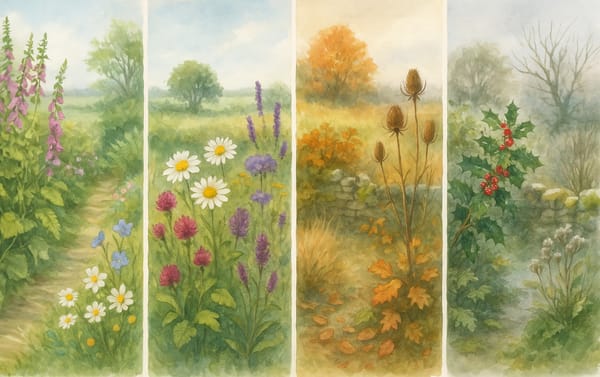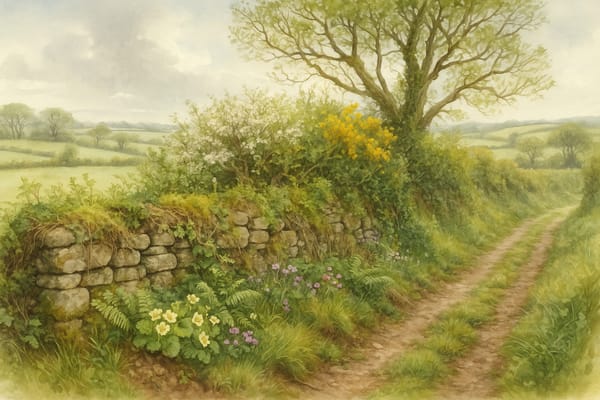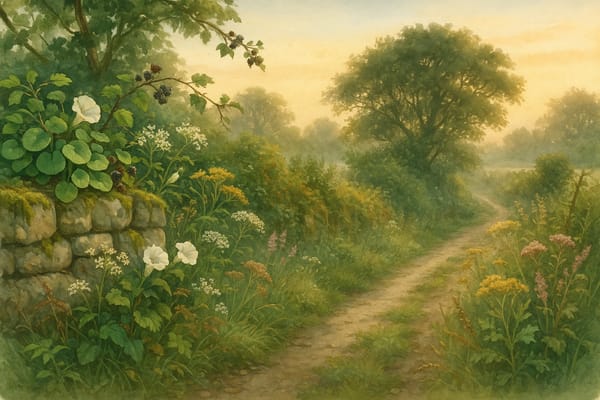In Cornwall, the shifting seasons bring more than a change in weather — they awaken a living rhythm in the garden. A well-planned wild Cornish garden hums with life in every season, offering colour, movement, and sanctuary for wildlife. It’s not about high-maintenance planting or chasing perfection, but about working with nature’s quiet cycles, using native plants, and embracing the natural beauty of change.
Here’s how to shape a four-season wild garden that celebrates Cornwall’s unique landscape, encourages biodiversity, and brings quiet joy all year long.
Spring: Awakening the Garden
Spring marks the great awakening. It begins with a shimmer of colour beneath hedges and woodland edges as native bluebells, wild daffodils, snowdrops, and wood anemones rise from winter’s rest. These delicate pioneers brighten shady corners and draw pollinators back into the garden.
Hedgerows come alive with blossom — blackthorn’s sharp white sprays, hawthorn’s soft flowers, and the silvery catkins of goat willow. These early blooms offer vital nectar for bees and hoverflies as they stir from hibernation.
Ponds return to life too. Frogs and newts arrive to spawn, while pond edges, softened by water mint or marsh marigold, become a hub of hidden activity.
Early spring is the time to gently clear away old seedheads, making space for the year’s first growth without disturbing overwintering creatures.
Summer: Abundance and Colour
Summer in a wild Cornish garden is an unruly celebration of life. Meadow patches brim with colour — knapweed, oxeye daisies, red and white clover, buttercups, and birds-foot trefoil sway in a pollinator-rich tapestry. Leave them unmown until late summer and watch bees, butterflies, and hoverflies arrive in abundance.
Hedgerows, far from mere boundaries, hum with life as wild rose, honeysuckle, and elderflowers bloom. They offer food, nesting sites, and corridors for wildlife moving between gardens and countryside.
Even a small pond becomes a bustling summer habitat. Dragonflies flash over the water’s surface, amphibians hide among pondweed, and birds drink and bathe at the edges.
In high summer, water becomes a lifeline. A simple dish or rain-filled tub can sustain everything from thirsty birds to bees.
Autumn: Seeds, Berries, and Nature’s Riches
Autumn is the garden’s generous heart — a season of seed, berry, and shelter.
Hedgerows drip with hawthorn, rowan, guelder rose, dogwood, and bramble berries. They are nature’s pantry, feeding flocks of resident birds and migrants arriving from colder shores.
Tall plants like teasel, knapweed, and thistle, left to dry and stand, offer food and dramatic silhouettes. Their seedheads not only add autumn interest but also feed finches and other seed-eating birds.
Trees and shrubs shift into a rich palette of amber, crimson, and gold. Hazel, spindle, and field maple ignite the garden with colour before their leaves fall to create soft shelters for insects and hedgehogs.
Autumn is the perfect time to leave the rake aside — gather leaves loosely beneath hedges or into composting heaps where they’ll shelter wildlife over winter.
Winter: Quiet Beauty and Shelter
Winter in a wild garden holds its own quiet kind of beauty. Amid the bare branches, evergreen plants step forward. Holly, ivy, and scots pine bring structure and offer critical shelter for birds, mammals, and insects seeking refuge.
Mosses, softened by damp Cornish air, cloak stone walls, logs, and earth banks in vivid green — a subtle but enchanting presence through the grey months.
Seedheads of yarrow, knapweed, and wild grasses, touched by frost, become sculptures in their own right while sheltering overwintering insects beneath their hollow stems.
Hedgerows, piles of brash, and patches of untamed garden become safe havens for wrens, robins, hedgehogs, and ladybirds. In Cornwall’s mild winters, these creatures remain quietly active, seeking food and shelter where they can.
Resist the urge to clear away every tangle. Winter’s messy corners are treasure troves for wildlife.
Year-Round Habitat Features for a Wild Cornish Garden
| Feature | Seasonal Value |
|---|
| Native Hedges | Food, cover, nesting — all year round |
| Wildflower Lawn | Blooms from spring through late summer |
| Pond | Active in all but the coldest months |
| Log Piles | Overwintering spots and year-round shelter |
| Berry Shrubs | Autumn and winter food for birds |
| Evergreens | Winter shelter and visual structure |
Crafting a Four-Season Wild Cornish Garden: What Matters Most
- Plant for Succession: Choose native plants that bloom, fruit, or offer shelter in different seasons.
- Embrace Controlled Wildness: Allow self-seeding, encourage “messy corners,” and reduce unnecessary maintenance.
- Work with the Cornish Climate: Mild winters mean more active wildlife in colder months — support them with evergreen cover, food sources, and natural shelters.
A wild Cornish garden doesn’t stand still. It shifts with the seasons, offering colour, sound, and quiet wonder every month of the year. By planting for biodiversity and embracing the natural flow of life, you’ll shape a garden that’s as full of joy and discovery in January as it is in June.
It isn’t about keeping up appearances — it’s about letting nature take root and flourish in your corner of Cornwall.











